
Nuts and seeds are more than just tasty snacks. These versatile ingredients can elevate any dish with their unique flavors and textures. Not only that, but they also pack a punch of nutrition that can benefit your overall health. From almonds to chia seeds, each nut and seed has its own unique flavor profile that can enhance sweet and savory dishes alike. Whether you’re looking to add some crunch to a salad or make a vegan-friendly baked good, nuts and seeds are the perfect addition to any recipe.
Popular Nuts
Almonds
Almonds are a popular tree nut that are known for their oval shape and beige color. They are a member of the Rosaceae family and are closely related to peaches, apricots, and cherries. Almonds have a hard, outer shell that is typically removed before consumption to reveal the edible nut inside. Almonds come in two main types: sweet and bitter. Sweet almonds are the most commonly consumed type and have a mild, nutty flavor. Bitter almonds, on the other hand, are not typically eaten on their own due to their high cyanide content.
Culinary uses and pairing suggestions
Almonds are a versatile ingredient that can be used in a variety of culinary applications. They can be enjoyed on their own as a snack or used to add crunch to salads and other savory dishes. Ground almonds can be used to make almond flour, which is a popular ingredient in gluten-free baking. Almond milk, made by blending almonds with water, is a popular plant-based milk alternative.
Almonds pair well with a variety of flavors, including chocolate, honey, and cinnamon. They can be used to add texture and flavor to baked goods like cakes, muffins, and cookies. Almonds also pair well with fruit, especially berries and stone fruits like peaches and apricots.
Health benefits
Almonds are a nutrient-dense food that are rich in heart-healthy monounsaturated fats, fiber, and protein. They are also a good source of vitamin E, magnesium, and potassium. Studies have shown that consuming almonds may help to lower LDL (bad) cholesterol levels and reduce the risk of heart disease. Almonds may also help to promote satiety and aid in weight management. However, it is important to note that almonds are also high in calories and should be consumed in moderation as part of a healthy diet.
Walnuts
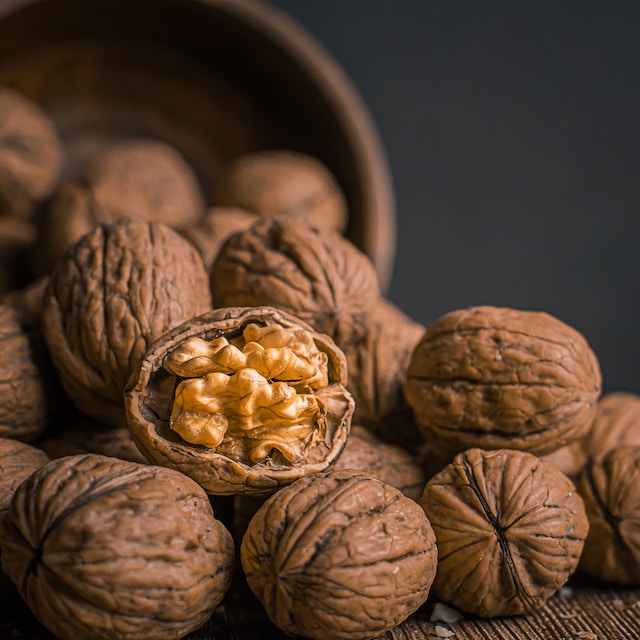
Walnuts are a popular tree nut that are known for their curved, hard shell and brain-like shape. They are a member of the Juglandaceae family and are closely related to pecans and hickory nuts. Walnuts are typically sold in their whole form or as halves or pieces. The edible kernel inside the shell is covered in a thin, paper-like skin. Walnuts have a buttery, nutty flavor with a slightly bitter aftertaste.
Culinary uses and pairing suggestions
Walnuts are a versatile ingredient that can be used in both sweet and savory dishes. They can be enjoyed on their own as a snack or used to add crunch to salads and other savory dishes. Chopped walnuts are commonly used in baked goods like cakes, muffins, and cookies. Walnuts pair well with a variety of flavors, including chocolate, maple syrup, and cinnamon. They can be used in savory dishes like roasted vegetables or as a topping for oatmeal or yogurt bowls.
Health benefits
Walnuts are a nutrient-dense food that are rich in heart-healthy monounsaturated and polyunsaturated fats, fiber, and protein. They are also a good source of vitamin E, magnesium, and phosphorus. Studies have shown that consuming walnuts may help to improve brain function and reduce the risk of heart disease. Walnuts may also help to reduce inflammation in the body and promote a healthy gut microbiome. However, as with all nuts, walnuts are also high in calories and should be consumed in moderation as part of a healthy diet.
Cashews
Cashews are a kidney-shaped nut, originally native to Brazil, with a smooth, creamy texture and a mild, buttery flavor. They belong to the Anacardiaceae family, which also includes mangoes and pistachios.
Most commercial cashews are steamed or roasted to remove their shells, revealing the edible cashew nut inside. Cashews are also unique among nuts because they produce a toxic resin between the shell and nut which must be removed before they can be eaten.
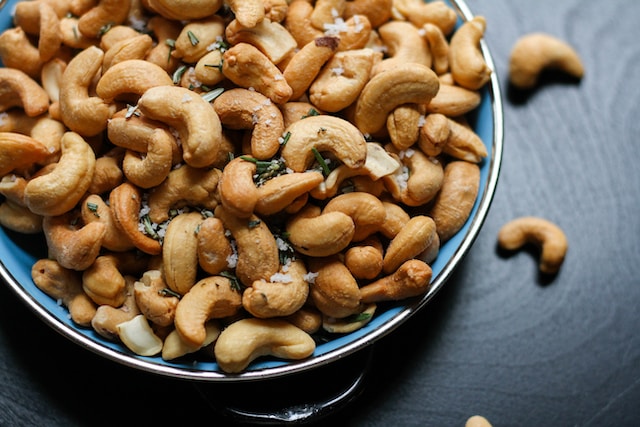
Culinary uses and pairing suggestions
Cashews are a versatile ingredient that can be used in both sweet and savory dishes. They can be enjoyed on their own as a snack or used to add creaminess and nuttiness to sauces and dips, such as cashew butter or vegan cheese. Cashews can also be ground finely and used in place of flour or breadcrumbs to coat meats or vegetables before cooking. Cashews pair well with a variety of flavors, including coconut, curry, and honey. They can be used in desserts like cheesecakes, puddings, and ice creams, much like cream or milk.
Health benefits
Cashews are a nutrient-dense food that are rich in healthy unsaturated fats, plant-based protein, and fiber. They are also a good source of vitamins and minerals, including copper, magnesium, and zinc. Studies have suggested that consuming cashews may improve heart health, reduce inflammation, and aid weight loss. Cashews also contain compounds that may help to reduce oxidative stress in the body, which can lead to chronic diseases such as cancer and diabetes. However, like all nuts, cashews are high in calories and should be consumed in moderation as part of a healthy diet.
Pistachios
Pistachios are a small, green-colored nut that have a mild flavor with a slightly sweet and salty taste. They are a member of the Anacardiaceae family, which also includes cashews and mangoes.
Pistachios are unique because they have a hard, beige-colored shell that splits open when the nut is ripe. The edible part of the pistachio is the bright green kernel inside the shell, which is covered by a thin, brownish-red skin.
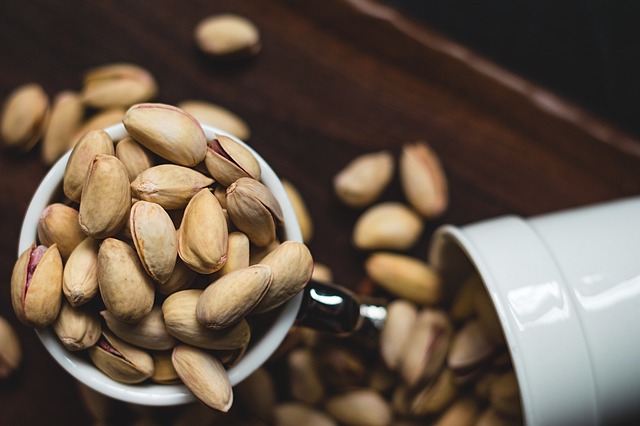
Culinary uses and pairing suggestions
Pistachios are a versatile ingredient that can be used in both sweet and savory dishes. They can be enjoyed on their own as a snack or used to add crunch and flavor to a variety of dishes like salads, roasted vegetables, and pasta. Pistachios also pair well with a variety of flavors, including chocolate, citrus, and honey. They can be used to make pesto, added to soups for texture, and used to top desserts like ice cream and cakes for a playful crunch.
Health benefits
Pistachios are a nutrient-dense nut that are rich in protein, healthy fats, and fiber. They are also a good source of vitamin E, magnesium, and potassium. Studies have shown that incorporating pistachios into a balanced diet may lead to improved cardiovascular health, lower cholesterol levels, and improved blood sugar control. Additionally, the high fiber content of pistachios may help to promote satiety and regulate digestion. However, like other nuts, pistachios are also high in calories and should be consumed in moderation as part of a healthy diet.
Incorporating a variety of nuts and seeds into your diet can provide a range of health benefits while enhancing the taste and texture of your meals.
Popular Seeds
Seeds are a great source of nutrition and can add flavor and texture to many dishes. Here are some popular seeds and their characteristics, culinary uses and pairing suggestions, health benefits and nutritional information.
Chia Seeds
Chia seeds are small black or white seeds that come from the Salvia hispanica plant, which is a member of the mint family. They have a mild, nutty flavor and a gelatinous texture when soaked in liquid.

Culinary uses and pairing suggestions
Chia seeds can be used in a variety of ways, including as a topping for yogurt, oatmeal or smoothie bowls, as a thickening agent in recipes or as an egg substitute in vegan baking. They can also be sprinkled on salads or used in dressings. Chia seeds pair well with flavors like honey, citrus or cinnamon.
Health benefits
Chia seeds are rich in fiber, good fats (omega-3), protein, and some micronutrients like calcium, magnesium and zinc. Studies have shown that consuming chia seeds may help with weight management and improve heart health by reducing blood pressure and inflammation.
Sunflower Seeds
Sunflower seeds are the edible fruits of the sunflower plant. They have a firm outer shell with a black and white striped kernel inside. They have a light, nutty flavor and a creamy texture.
Culinary uses and pairing suggestions
Sunflower seeds can be used in a variety of ways, including as a snack, in breads, cookies or granola bars. They can also be added to salads, pestos, and sauces. Sunflower seeds pair well with ingredients like honey, chocolate, or dried fruits.
Health benefits
Sunflower seeds are high in healthy fats, fiber, protein, and some micronutrients like vitamin E, magnesium, and selenium. Studies have shown that consuming sunflower seeds may help with reducing inflammation and improve heart health.
Flax Seeds
Flax seeds are small, brown or golden seeds that come from the flax plant. They have a slightly nutty flavor and a crunchy texture.
Culinary uses and pairing suggestions
Flax seeds can be used in a variety of ways, including as a topping for oatmeal or yogurt, in smoothies, or in baked goods. They can also be used as a substitute for eggs in vegan baking or mixed with water to make a flax egg. Flax seeds pair well with ingredients like maple syrup, cinnamon, or pumpkin.
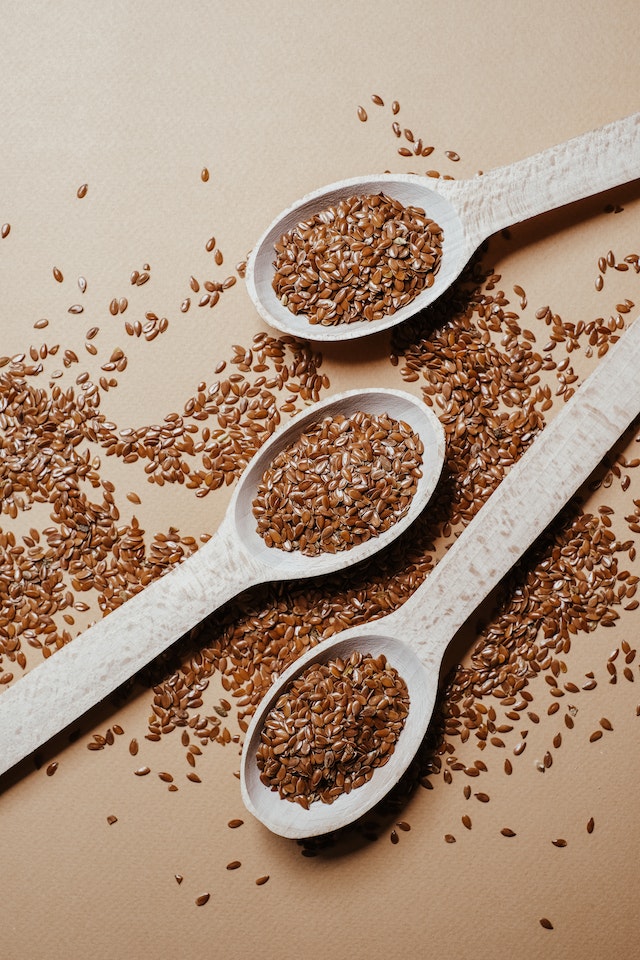
Health benefits
Flax seeds are rich in fiber, protein, healthy fats (omega-3), and some micronutrients like magnesium and manganese. Studies have shown that consuming flax seeds may help with reducing inflammation, improving heart health and digestion.
Pumpkin Seeds
Pumpkin seeds, also known as pepitas, are the edible seeds of pumpkins. They have a slightly sweet and nutty flavor and a crunchy texture.
Culinary uses and pairing suggestions
Pumpkin seeds can be used in a variety of ways, including as a snack, in trail mix, or as a topping for salads or soups. They can also be used in baking or blended into a pesto. Pumpkin seeds pair well with ingredients like cinnamon, maple syrup, or chocolate.
Health benefits
Pumpkin seeds are rich in fiber, protein, healthy fats, and some micronutrients like magnesium and zinc. Studies have shown that consuming pumpkin seeds may help with reducing inflammation, improving heart health, and prostate health in men.
Sesame Seeds
Sesame seeds are small, flat seeds that come from the sesame plant. They have a nutty flavor and a crunchy texture.
Culinary uses and pairing suggestions

Sesame seeds can be used in a variety of ways, including as a topping for bread or crackers, in marinades or dressings, or as a coating for chicken or fish. They can also be used in tahini or hummus. Sesame seeds pair well with ingredients like soy sauce, ginger, or honey.
Health benefits
Sesame seeds are rich in healthy fats, protein, fiber, and some micronutrients like calcium and magnesium. Studies have shown that consuming sesame seeds may help with reducing inflammation, improving heart health and blood sugar control.
Incorporating a variety of seeds into your diet can add flavor and nutrition to your meals. Experiment with different ways to use these versatile ingredients and enjoy the numerous culinary possibilities they offer.
Cooking Tips and Recipes
Nuts and seeds can be used in a wide variety of recipes, from savory to sweet. Here are some suggestions on incorporating nuts and seeds into everyday meals, highlighting specific recipes that showcase their unique flavors and textures, and tips on how to store them properly.
Incorporating nuts and seeds into everyday meals
- Sprinkle them on top of oatmeal, yogurt, or salad for extra crunch and nutrition.
- Use nut flours as a gluten-free alternative in baking. Almond flour is a great option for making macarons or cakes, while hazelnut flour is perfect for making gluten-free brownies.
- Create a DIY trail mix with your favorite nuts and seeds, dried fruits, and dark chocolate chips for a healthy and tasty snack.
- Make your own nut butter by blending roasted nuts in a food processor until smooth. Add a little bit of salt and sweetener (like honey or maple syrup) to taste.
- Roast or toast nuts and seeds in the oven or on the stovetop to enhance their flavor. Add them to stir-fries, pasta dishes, or even roasted vegetables.
Recipe Suggestions
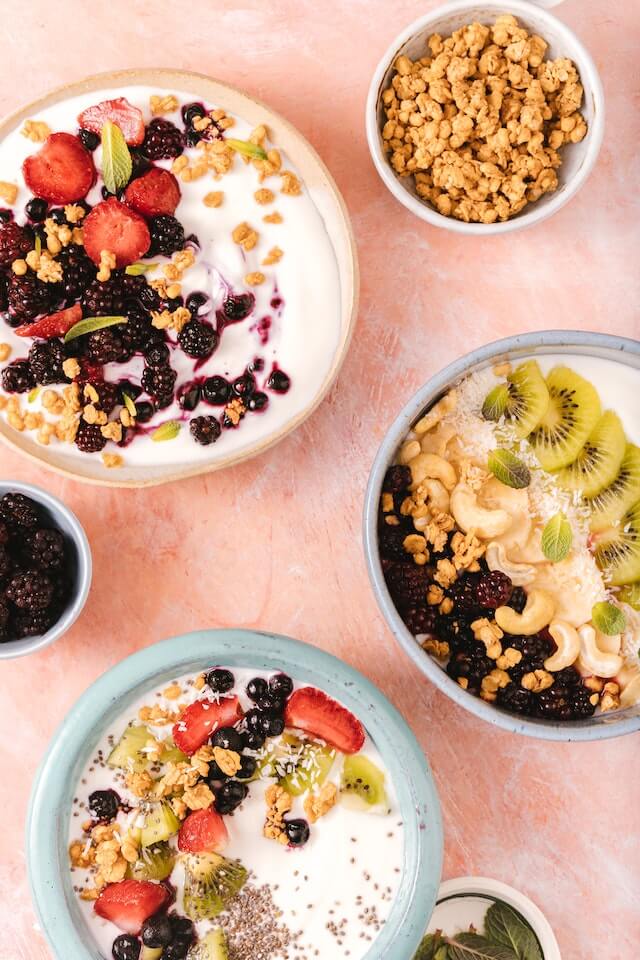
1. Almond Butter and Jelly Smoothie: Blend together almond butter, frozen berries, banana, and almond milk for a quick and delicious breakfast smoothie.
2. Pistachio Crusted Salmon: Coat salmon fillets in a mixture of chopped pistachios, breadcrumbs, and herbs before baking for a flavorful and healthy dinner option.
3. Chia Seed Pudding: Mix chia seeds with almond milk, vanilla extract, and sweetener of choice for a creamy and nutritious dessert or breakfast.
4. Moroccan Spiced Roasted Carrot Salad with Toasted Sesame Seeds: Toss roasted carrots with a mixture of cumin, coriander, and paprika. Top with goat cheese, toasted sesame seeds, and a lemon vinaigrette for a hearty and flavorful salad.
5. Maple Pecan Granola: Combine rolled oats, chopped pecans, cinnamon, and maple syrup in a baking dish. Bake until golden brown and crisp, stirring occasionally. Serve with yogurt or milk for a satisfying breakfast.
Storage Tips for Nuts and Seeds
- Store nuts and seeds in airtight containers in a cool, dry place to preserve their freshness. Some nuts, like walnuts, have a high fat content and can go rancid quickly, so it’s important to keep them in the fridge or freezer.
- If you buy nuts and seeds in bulk, transfer them to smaller containers to minimize air exposure and prolong their shelf life.
- Be mindful of expiration dates, as nuts and seeds can lose their flavor and nutritional value over time. Check them periodically for signs of spoilage, such as a rancid smell or taste.
Incorporating nuts and seeds into your diet is not only a great way to add flavor and texture to your meals but also provides a range of health benefits. From heart-healthy fats to fiber and protein, these small but mighty ingredients can have a big impact on your overall health. So whether you’re sprinkling them on top of your breakfast or incorporating them into your favorite recipes, remember to enjoy the diverse culinary possibilities that nuts and seeds have to offer. With a little creativity and exploration, you can elevate your cooking and nourish your body at the same time.
